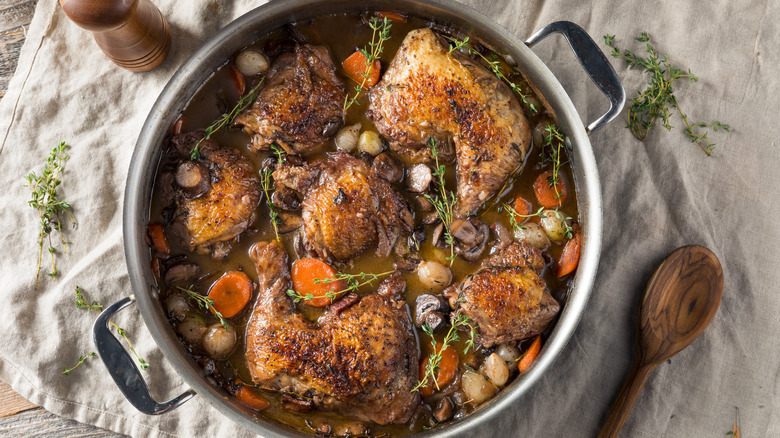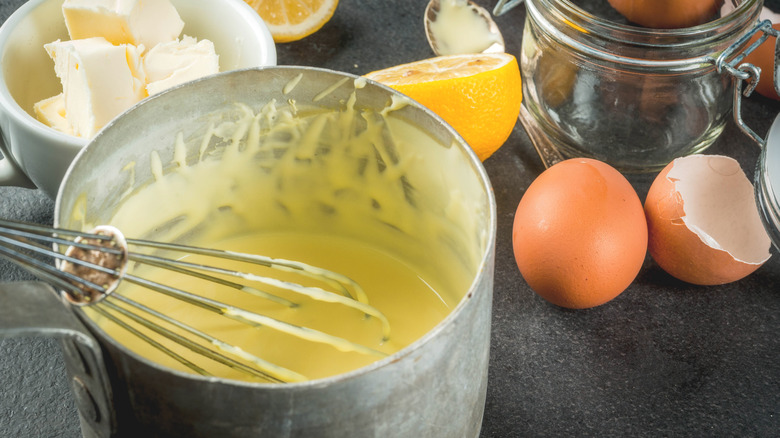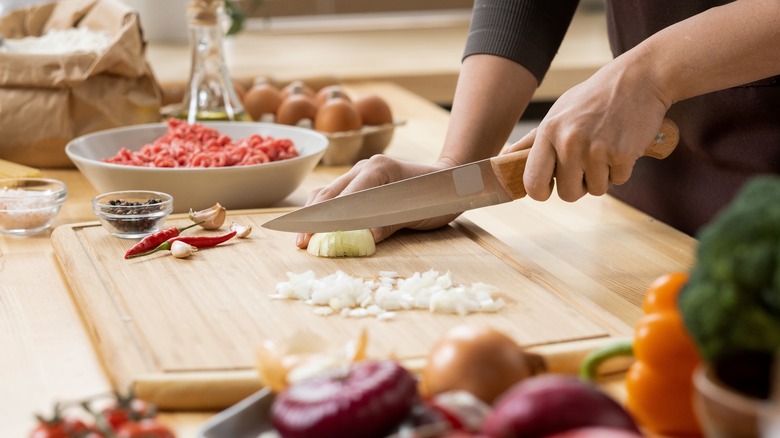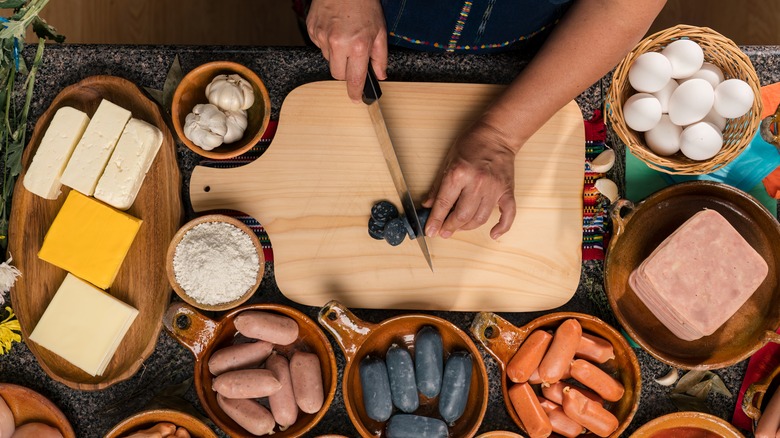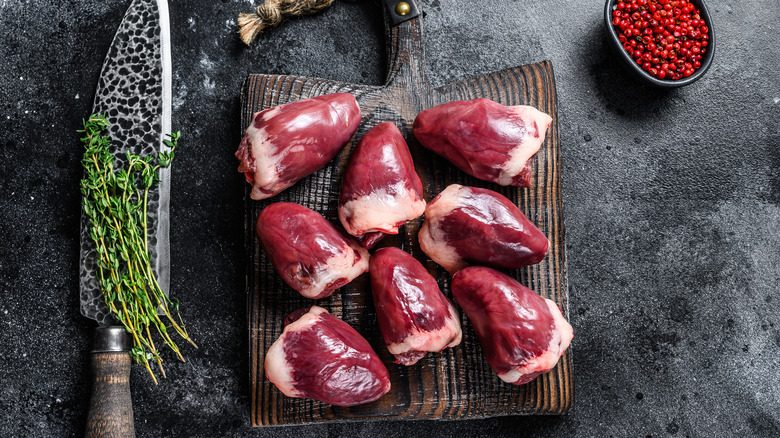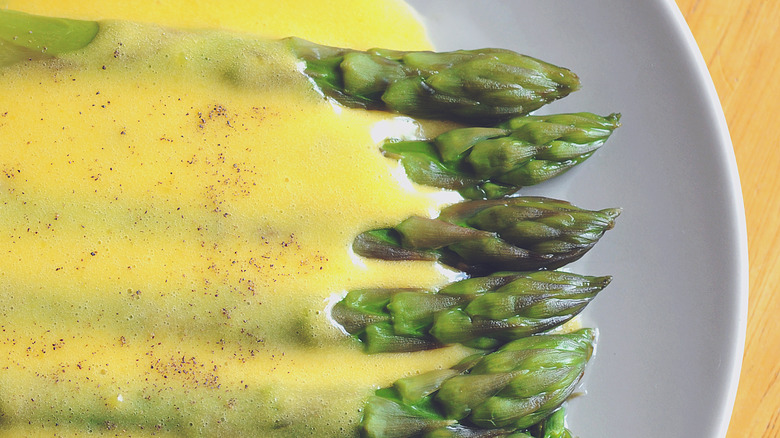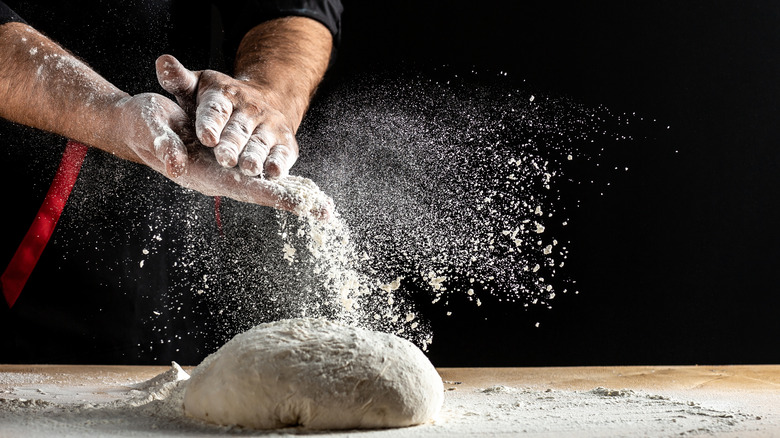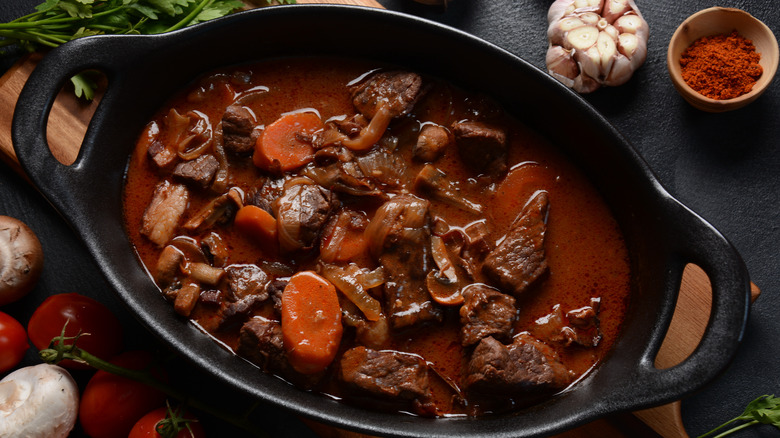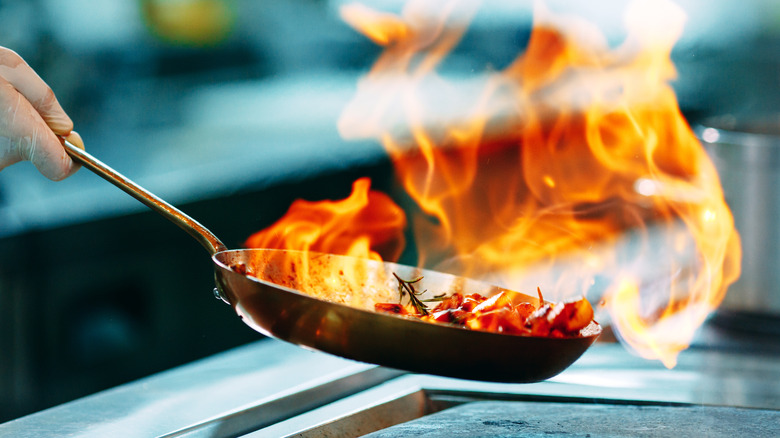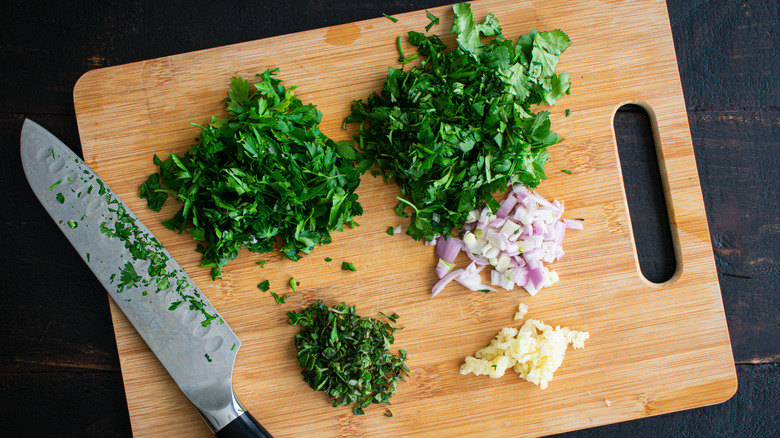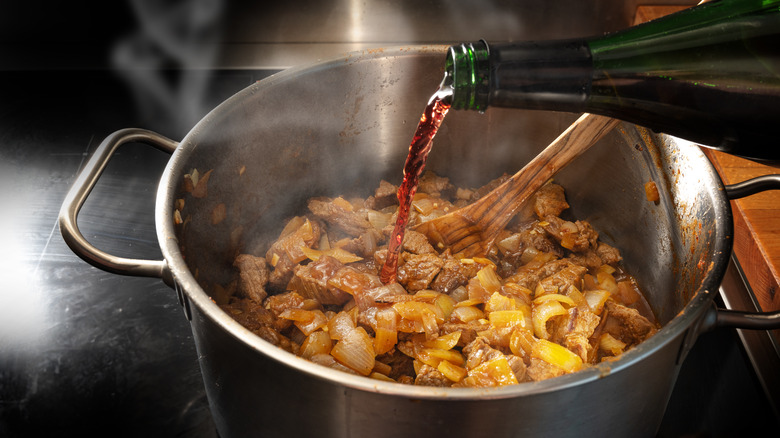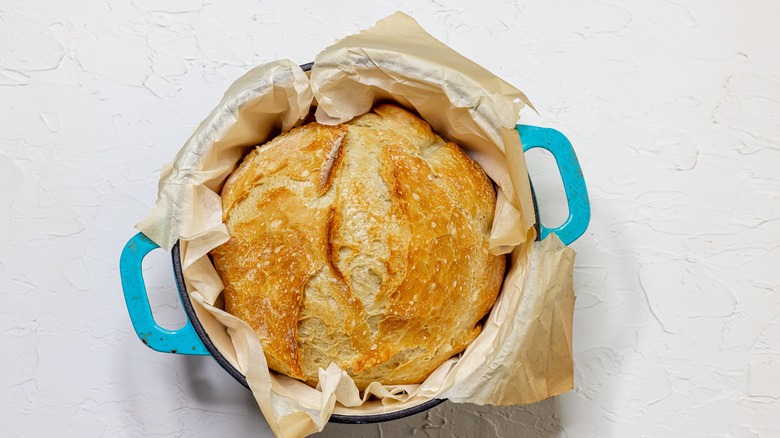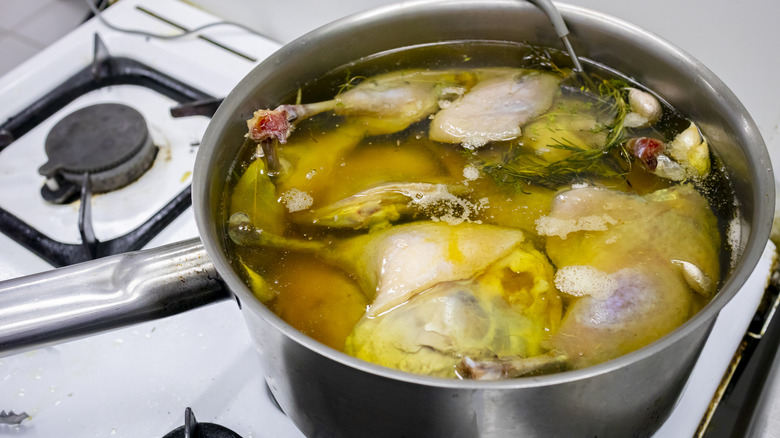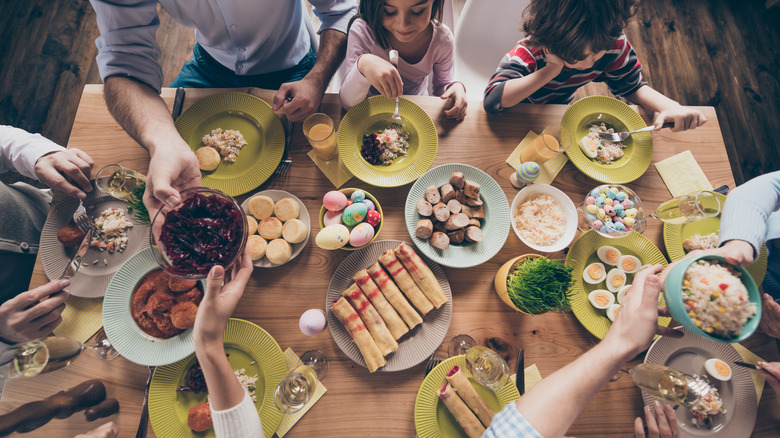The 14 Best French Cooking Tips For Home Chefs
Cooking has been a function of human life across cultures that span the globe, but the techniques employed by the French are held in particular esteem. It's for this reason that chefs around the world look to them for inspiration to create the most delicious food possible. Centuries of trial and error led the French to some of the most fundamental cooking practices that have been used throughout the culinary landscape. It's no wonder that some of the best chefs in history started their careers in France.
Even if French food isn't really to your personal taste, there are bound to be a few secrets, tips, or tricks borrowed from the French way of cooking that could make a difference in how you cook at home. Whether it's a tool or a technique, the French can be an inspiration to us all. Read on for some of the best French cooking tips to apply in your own cooking.
Master the sauces
One of the most foundational aspects of French cuisine is sauces. It's no small wonder that the most important sauces are known as the five "mother sauces": bechamel, espagnole, tomato, hollandaise, and veloute. (Demi-glace, which is sometimes listed as a derivative of espagnole, can be considered the sixth). From this list, almost all other sauces in French cooking are derived. Though some of these may sound extremely foreign to the American home cook, they really aren't. Classic turkey gravy served on Thanksgiving is actually a French veloute, which is to say a stock thickened with a roux a blend of flour and fat).
Other derivatives of these sauces include aioli (or mayonnaise), beurre blanc, tartar sauce, and even cheese sauce (the kind you would pair with macaroni), which in French cuisine is called Mornay. Mastering these sauces is key to any journey into French cooking. The sauce is often the key component of the dish that ties everything together and elevates the simple to the divine. Simple ingredients
Learn your knife cuts
One of the first things young cooks in culinary school learn is the importance of knife cuts and true French chefs never skip this essential part of the cooking process. It's a common misconception that knife cuts beyond a simple dice are mostly for visual effect. In fact, the way vegetables are cut can affect the final taste and texture of a dish. Smaller cuts cook faster and absorb more liquid than larger ones which could change the timing of the entire recipe if done incorrectly.
Mastering this aspect of French cooking can take time, but starting with the basics will yield immediate improvement. A classic dice, julienne, mince, baton, chiffonade, and brunoise are some of the most common types you will be likely to come across, so start there. If you don't have the time or resources to sign up for a cooking class, YouTube is a great resource for learning the best ways to achieve these cuts, as well as simple practice.
Mis en place is always key
"Mis en place" is a French term that means "put in place" or "set up." In the culinary world, it refers to the practice of organizing and preparing all the ingredients, equipment, and tools that a chef or cook will need for a particular dish or meal before cooking begins. This includes tasks such as chopping vegetables, measuring out ingredients, and organizing tools and equipment.
The concept of mis en place is important in professional kitchens because it helps ensure that the cooking process runs smoothly and efficiently. It also helps reduce the likelihood of errors or accidents occurring in the kitchen. Anyone who has ever started to cook a recipe and learned only during a crucial step in the middle they are out of a key ingredient can understand the importance of this foundational concept. To adopt this yourself, have all necessary ingredients and tools laid out before beginning the recipe, including vegetables that need to be cut or liquids measured out.
Don't be afraid of the off-cuts and offal
In America, it is much more common to see the same cuts of meat over and over again in the store. Boneless, skinless chicken breast, sirloin steaks, and salmon filets line the shelves of the average grocery store, with other types of meat relegated to a tiny section, if there are any available at all. The French not only cook with a much more diverse palate, but they make sure to utilize more parts of the animal.
Offal, the term given to the various edible internal organs of an animal, makes up a huge chunk of the French pantry. Things like chicken liver pate, terrines, foie gras, sweetbreads, bone marrow, even pig's feet (or pied de cochon), are all common French dishes. Don't be hesitant to expand your repertoire to include these ingredients. You'll be amazed how an entirely new world of flavor opens to you.
Keep it simple but seasonal
Many French dishes use only a few ingredients but those tend to be of the finest quality and the maximum amount of flavor is coaxed out using the right techniques. Take French onion soup, for example. Most people would think of the simple onion as more of a supporting role than the main star. But with this classic, the onion takes center stage and every possible molecule of flavor is brought forward, from the caramelized onions to the rich broth.
To cook like the French, look for seasonal ingredients harvested at the peak of flavor and prepare them simply. In the spring, it's not uncommon on a menu in France to see asparagus, served lightly blanched and topped with just a bit of hollandaise. Of course, you would only see this in a certain season. By fall, asparagus will be replaced by mushrooms and root vegetables.
Utilize the fraisage
Most home cooks already know about pie dough, or pate brisee, as it's called in France. This light and flaky dough serves as the base for pies, quiches, and other excellent dishes. Making pie dough can be difficult for even the most knowledgeable cooks, so it might surprise you to know that there is an additional level of technique that French chefs utilize. This is known as the fraisage method.
Once mastered, the fraisage method will forever change how you make pie crust. It begins the same: When the chunks of butter are cut into the flour, the liquid is added. Then, place the dough on a work surface and work the butter into long, thin sheets using the heel of your hand. This final blending makes all the difference in the world, and could be the solution to your pie crust woes if you never can quite get the hang of it.
Cook the classics
There is a lot to know about cooking food the proper French way. So much so that entire college degrees focus on little else. One of the best ways to absorb all this knowledge is to cook all the classic French dishes. There are several vital French dishes that every cook needs to try at least once, from boeuf bourguignon to bouillabaisse. Each of these recipes highlights at least one important French culinary technique.
Think of it like an at-home speed run through culinary school. Follow each of these delicious recipes to the letter and by the end, you will have at least a basic understanding of most of the key French cooking principles. They may not turn out perfectly the first time, but exposure to a technique is the first step on the road to mastery. With time, these techniques will become like second nature.
Pair wine perfectly
The French love their wine, and as the great chef Auguste Escoffier once said, "fish without wine is like egg without salt" (via Taste of France). There are a few key principles that the French follow when pairing wine with food. The first is to match the weight and intensity of the wine with the weight and intensity of the dish. For example, a light, delicate white wine would not be a good match for a rich, heavy dish like beef bourguignon.
Next, consider the flavors and textures of the dish. For example, a wine with high acidity can help balance the richness of a creamy sauce, while a wine with fruity flavors can complement a dish with sweet or fruity elements. Don't be afraid to experiment and try different combinations to see what works best for you. Ultimately, the best wine pairing is one that you personally enjoy. Beginners should start with classic wines for a basic understanding of what flavor profiles work well together and go from there.
Don't stir, sauté
A French word meaning "to jump," sauté refers to the culinary technique of cooking vegetables in a hot skillet. Using a quick motion of the wrist, vegetables can be quickly turned by allowing them to fly up over the rim of the pan and back onto themselves. This technique not only saves time but ensures even cooking and browning by letting each item get an equal amount of time in contact with the pan.
Even if you are familiar with the technique, there may be one important sautéing rule you are overlooking: The proper amount of oil is crucial. An even layer across the bottom of the pan is absolutely vital to having good results with this technique. The actual amount will differ depending on the size of the pan, but a few tablespoons should be more than enough. An insufficient amount of oil could lead to scorching and uneven cooking.
Take care of your knives
Perhaps it goes without saying, but a chef not caring for their knives is like a race car driver avoiding an oil change. A true master is only as good as his tools and no great food can be made without a good sharp knife. First, start with a good chef's knife. A useful knife need not be expensive if it is maintained properly.
Be sure to keep your knife sharp, either by learning to sharpen it yourself or taking it to a professional. Learn the difference between honing (straightening the edge while keeping it intact) and sharpening (removing portions of the blade in order to establish a brand-new edge). Never put a knife in the dishwasher and avoid allowing the blade to touch metal which will dull the edge. You also want to avoid storing your knife in a drawer and instead, protect the edge by investing in a knife cover. Finally, you can prevent rusting by making sure the blade is completely dry after washing.
Use alcohol to its fullest advantage
When it comes to French cooking, alcohol isn't just for drinking. Wine and other liquors often play vital roles in transforming the taste and texture of a dish. Wine and Pernod can be used to poach fish, as well as to create a light but lovely beurre blanc. Heartier dishes like coq au vin employ wine in the braising process, which cooks down to create a rich and flavorful broth. The classic French technique of flambé is when a small amount of alcohol is added to a hot pan. The liquid begins to evaporate and catches on fire, rapidly burning off the alcohol and leaving only the taste behind. (Just remember to flambé safely by taking the pan off the heat prior to adding the alcohol.)
Deglazing is the process of adding alcohol (often wine) to sautéed and caramelized vegetables. The browned bits on the bottom of the pan (known as the fond in French) begin to steam and release from the pan so that flavor can be incorporated into the dish.
Make the most of parchment paper
Parchment paper, also known as baking paper, is a versatile kitchen tool that is widely used in French cooking. It is made from a thin, heat-resistant material that is coated with a non-stick substance, making it ideal for use in baking and cooking. In French cuisine, parchment paper is often used in a variety of ways, including making packets for cooking (a technique known as en papillote). The food inside is steamed by the flavorful juices released during the cooking process.
Aside from lining baking pans and sheet trays when making cookies, cakes, and other baked goods, parchment paper can also be made into a makeshift pot lid. This method is known as the cartouche and is also used to line the tops of sauces while they cool to avoid forming a skin. It's the small details that set apart average dishes from the supreme.
Cook with liquid gold
The French have never shied away from utilizing fat wherever necessary. In the immortal words of Julia Child, author of "Mastering the Art of French Cooking," "if you're afraid of butter, use cream." Fat is the liquid gold that can completely change a dish for the better and substitutes rarely deliver the same flavor or texture. It's no wonder that this is the cuisine that brought us the French fry, perhaps one of the most popular foods eaten worldwide (and made from the most humble of vegetables, no less).
The French use ample amounts of fat in all types of cooking, from frying to confit, a technique where cuts of meat or vegetables are braised in a pot of liquid fat. Perhaps the most famous dish using this technique is duck confit, a heavenly recipe that calls for slowly cooking cured duck legs in flavored molten duck fat.
Be sure to take the time to enjoy the meal
In France, meals are typically seen as an opportunity to relax and enjoy good food and company. It is common for people to take their time when eating, rather than rushing through a meal. In fact, it is considered impolite to eat too quickly in France. One way that the French take the time to savor a meal is by setting aside a dedicated time for eating. It is common for people to have long, leisurely meals at lunch and dinner, rather than eating on the go or at their desks.
There is also a strong emphasis on the presentation of food. Food is often carefully arranged on the plate and served in small, manageable portions, which allows people to appreciate the aesthetics of the dish as well as its flavor. Finally, the French often take the time to enjoy a leisurely conversation over a meal. Rather than rushing through a meal to get back to work or other activities, it is common for people to spend hours chatting and enjoying each other's company while eating.
